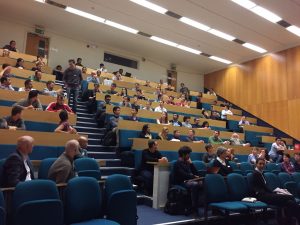Branch
Select your branch
Innovation in Oxfordshire and trends shaping the industry
Oxfordshire – the place to drive innovation!
Has the innovation ecosystem in Oxfordshire been changing over the recent years?
What lessons can we learn from the stories of successful biotech companies?
An audience of nearly 100 academics and young entrepreneurs gathered on 12th October in the lecture theatre of John Radcliffe Hospital. There, Sir John Bell opened the lecture series on Health and Life-Sciences Entrepreneurship, organised by the Oxford branch of Innovation Forum in collaboration with the MRC Weatherall Institute of Molecular Medicine and University of Oxford’s Medical Sciences Division. In his inspirational talk, Sir John addressed the role of Oxfordshire in driving global biotech innovation and shared lessons from the past which can shape the future of the industry.

Professor Sir John Irving Bell GBE FRS FMedSci FREng graduated from Medicine at the University of Oxford. After working as a Clinical Fellow at Stanford, he returned to Oxford in 1992. His major contributions to the University include co-founding the Wellcome Trust Centre for Human Genetics and serving as the Regius Professor of Medicine since 2002. Throughout his career he has served on boards of large companies, including Roche, AstraZeneca and Genentech. He has also advised a number of charities, including Bill and Melinda Gates Foundation, the Oak Foundation and the Robertson Foundation.
Sir John was once a student at the University of Oxford himself. Since then, he has witnessed two of the greatest worldwide advancements: the decrease in mortality rate and more than eight-year increase in life expectancy. Although this long-term achievement, driven by pharmaceuticals and technology, has presented a lot of issues along the way, it was definitely worth the effort. But how can we ensure that the future innovators build on this exciting trend?
Innovation works best in environments where two or more disciplines intersect. For example, LMB in Cambridge, where physics and biology go side by side, produced several Nobel prize winners. Moreover, universities, where academic scientists have a certain degree of research freedom, create environments that favour innovation.
How does Oxfordshire fit in this picture?
In fact, Oxfordshire is a great place for biotechnological innovation. The University of Oxford has been the world’s leading university in Biomedical Sciences for six consecutive years according to the Times Higher Education Ranking. The University scores particularly high at interactions with industry, thanks to the associated technology cluster.
Quantifying by output, Oxford is home to the most successful biomedical campus in Europe. The Old Road Campus, which started with the Wellcome Trust Centre for Human Genetics, co-founded in the 1990s by Sir John Bell himself, currently employs 2500 scientists. This expands to around 180 companies in Oxfordshire and 780 in whole Thames Valley. These include the Harwell campus, the site of really exciting developments, with increasingly more biologists on site. It will become home to the Rosalind Franklin institute, a new place for collaboration of physicists and biologists – another example of an interface that drives most powerful innovation.

Geographically, the English South-East triangle Oxford-Cambridge-London is the same size as Boston and Silicon Valley taken together. It is actually the biggest biotech area in Europe. However, there are no UK-based pharma companies in the top 10 of the market cap table. Clearly, there must be some lessons to learn.
Lessons from the past
Sir John Bell has been the founding director of a few biotech companies, including Oxagen or Avidex. The stories of these companies provide a source of useful advice. Our speaker shared several of them. For instance: Orient the innovation around patient needs. While companies may be working on improving patient’s condition, the most powerful innovations actually respond to what the patients actually want. Another point to keep in mind is the fact that developing a product may often be more difficult than discovery. Add the need to be patient and flexible and you arrive at the most important take-home message: Innovation takes time. A very long time, actually. Successful middle-size companies, such as Gilead, Genentech, Celgene or Novo Nordisk are all driven by breakthroughs, which took decades to achieve. How can we then ensure that the UK creates an ecosystem that provides enough time?
Sir John pointed out the need for new facilities and incubators. Actually, the newest addition to the Old Road Campus, the Bioescalator, is currently under construction. Among many useful resources, it will allow reduced costs for new start-ups by sharing management. It will also play a role in aiding the very much needed establishment of middle size life sciences companies.
Closing his talk, Sir John Bell pointed to a lot of patient capital currently coming to Oxford. Therefore, we will very likely witness Oxfordshire becoming the world’s new leading hub for life sciences innovation.
With his talk, Professor Sir John Bell opened the lecture series on Health and Life-Sciences Entrepreneurship, supported by the MRC Weatherall Institute of Molecular Medicine, University of Oxford’s Medical Sciences Division, Oxford University Innovation, Oxford Biomedical Research Centre, Saïd Business School, Enterprising Oxford, Oxford Academic Health Science Network, J&J Innovation, George James Ltd, Orangefield Group, Penningtons Manches and White October.
-
Pingback: Lecture Series in Health and Life-Sciences Entrepreneurship – 2016 recap | Oxford
-
Pingback: Join Innovation Forum Oxford! | Oxford
-
Pingback: HOW TO BECOME A SCIENCE-ENTREPRENEUR? INNOVATION FORUM OXFORD TRAINING ON HEALTH AND LIFE SCIENCES ENTREPRENEURSHIP | Oxford


